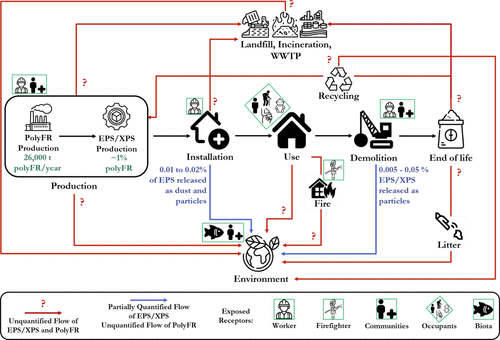February 2021 : Shades of Green
In this edition:
- 'Green Buildings' with Hazardous Chemicals Aren't Really Green
- Toxic Metals in Baby Food! Really?
- California is First to Regulate the Entire Class of PFAS
- Help Us Improve Our Newsletter and Win a Prize
- CALENDAR
I hope you are doing well as we approach the one year mark since the beginning of the pandemic. I am very grateful to have received my two COVID-19 vaccinations and hope that most of us can soon be vaccinated and safe from the coronavirus. As the pandemic subsides, we can focus more attention on slow-moving pandemics like chemical and plastic pollution and climate change.
An important part of preventing climate change is making buildings more energyefficient. However, our new commentary in Environmental Science & Technology explains why “green buildings” with foam insulation might not be so green. A flame retardant commonly used in such insulation, PolyFR, is assumed to be safe. However, it may break down into harmful chemicals that end up in people and ecosystems. You can read more below and in our press release.
Just like energy-efficient buildings, we think of recycling as green. But it isn’t always that simple. A recent study detected some of the world’s rarest metals along with bromine and antimony—markers of flame retardants—in plastic products such as children’s toys. This is likely because the products were made with recycled plastic. The study adds to previous research finding bromine, antimony, and lead in soup spoons and other products due to the use of recycled electrical equipment as a source of plastic. Reducing the use of harmful and unnecessary flame retardants in electronics in the first place will facilitate healthier recycling and a circular economy.
The ubiquity of hazardous chemicals in plastic and electronic waste is one example of a pollution problem that transcends national borders. In a new article in Science, our colleagues call for a global intergovernmental panel that would inform policymakers, businesses, and the public about reducing harm from chemical pollution. Every year, toxic chemical exposure is responsible for millions of deaths around the world. It’s a global health crisis that can be solved with global action.
In PFAS news, firefighters are taking a stand against the forever chemicals in their uniforms. A new series in E&E News suggests that the chemical industry has used its usual playbook of money and propaganda to promote the use of PFAS in firefighters’ clothing and gear. But a few weeks ago, members of the International Association of Fire Fighters voted almost unanimously to cut financial ties with chemical, textile, and gear manufacturers. Graham Peaslee’s research first finding the PFAS in their gear contributed to this and is another example of scientific research contributing to positive change. For a different view of PFAS pollution—from outer space—check out this three-minute video from Simona Balan, our colleague and previous Institute employee.
Read on to learn more about taking a survey to help us improve our newsletter and your chance to win a prize.
Warm regards,
Arlene and the Green Science Policy team
'Green Buildings' with Hazardous Chemicals Aren't Really Green
By Anna Soehl

Have you ever heard that large molecules called polymers, even those that are made up of harmful monomer building blocks, are nothing to worry about? The rationale is that polymers are too large to enter our cells and that bound chemicals have few opportunities to be released to the environment. But these are broad assumptions that have yet to be proven.
In a new commentary in Environmental Science & Technology, the authors (including three from our Institute) illustrate how the brominated flame retardant PolyFR can release harmful breakdown products into the environment during the manufacture, installation, and disposal of insulation. PolyFR is commonly used in rigid polystyrene building insulation (EPS and XPS, to be precise).
Since brominated PolyFR is used in high volumes (about 26,000 metric tonnes per year), and little is known about its environmental fate, the authors call for comprehensive assessments of this product’s potential for harm across its life cycle.
Importantly, alternative insulation materials exist which do not require the use of potentially hazardous flame retardants. Inherently flame-resistant mineral fibers, such as glass wool or stone wool, can be used instead. Also, the use of flame retardants in some building insulation has not been shown to provide a real-world fire safety benefit.
Making buildings more energy-efficient is an important tool for tackling the climate crisis. But we need to be careful not to create new health and environmental problems in the process. A 'green building' with potentially hazardous insulation isn't such a green building after all.
Toxic Metals in Baby Food! Really?
By Hannah Ray
In a congressional report released this month, heavy metals such as arsenic, lead, cadmium, and mercury were found in all 900 baby food products tested. Thirty of the baby foods had arsenic levels above the FDA regulated limit. The other metals do not have FDA limits and the report showed that products sometimes exceeded manufacturer’s own voluntary thresholds. This study followed on from a 2019 Healthy Babies Bright Futures report finding a similar result.
Due to their use in industrial applications, and their natural occurrence, heavy metals can be present in soil and water, and then taken up into the food we eat. Foods such as rice, sweet potatoes, carrots, fruit juices and large fish can contain heavy metals at higher levels than other foods.
As detailed on our Six Classes website, lead, arsenic, cadmium, and mercury are four heavy metals of concern. These metals bioaccumulate, and exposure has been associated with neurodevelopmental issues, cancer, and other health problems. In Bangladesh, where very high levels of inorganic arsenic are prevalent in the drinking water, studies have correlated high urinary arsenic levels with lowered IQs.
In the congressional report, the 30 products with heavy metals above the regulated threshold were mostly rice-based products such as puffs, teethers and cereal with high inorganic arsenic. What can be done? Manufacturers can modify their sourcing and manufacturing protocols. Concerned parents can limit the amounts of large fish, rice products, sweet potatoes, and fruit juice in their children’s diets.
We hope that the congressional report will spur action for safer, healthier baby food.
California is First to Regulate the Entire Class of PFAS
By Carol Kwiatkowski
The California Department of Toxic Substances Control (DTSC), under its Safer Consumer Products Program, will be the first government agency to regulate the entire class of PFAS. The rationale is that all PFAS are extremely persistent leading to increasing exposures and increased potential for health risks.
According to lead author Simona Balan and the other DTSC staff who authored a recently published commentary, “Because individual PFAS never occur in isolation, we believe they cannot be effectively regulated in isolation.” Regulating the entire class of PFAS prevents regrettable substitutions, where one PFAS replaces another similar molecule, and avoids the “ineffective and impractical” method of regulating such a large and complex class of chemicals with a piecemeal approach.
According to the authors, all PFAS or their degradation, reaction, or metabolism products have at least one hazard trait of concern to the State of California: Persistence. Other hazard traits for various PFAS include bioaccumulation in plants and animals, mobility in the environment, lactational and transplacental transfer to offspring, and numerous toxicological health hazards.
The Safer Consumer Products Program addresses products (excluding pesticides, food, and pharmaceuticals) that contain chemicals of concern to DTSC. Possible regulatory responses include 1) restrictions or prohibitions on the sale of a product, 2) requirements for labeling or safe handling, 3) engineering or administrative controls to reduce exposure, 4) end-of-life product management, and 5) investment in developing safer alternatives. Applying these controls to PFAS is a huge step forward for protecting health and the environment and creates a model for other regulatory bodies.
Help Us Improve Our Newsletter and Win a Prize
Thank you so much for being a subscriber to the Green Science Policy Institute’s monthly e-newsletter. For more than a decade, our newsletter has provided new and useful information about chemicals of concern, science, policy, and protecting health. Now we want to make our newsletter even more accessible, interesting, and relevant to you. If you haven’t already, might you fill out the quick survey here to help us do that?
As a thank you, participants will be entered into a raffle to win a goody bag including some of our favorite books and chocolates.
CALENDAR
If you’d like to catch up on emerging PFAS science, our PFAS Central website maintains a list of upcoming events. A number of interesting webinars are happening in the next few weeks.
---------------------
March 10, 17, 2021: Science & Communication Strategy Workshop
When: 10:00 A.M. - 12:30 P.M. PST
Scientists and communications experts will share inspirational stories and practical advice to increase the impact of participants' research during our Institute's pilot Science and Communication Strategy Workshop. During interactive exercises and small and large group discussions, participants will develop tools to use their research to better protect public health.
The Science and Communication Strategy Workshop is full and no longer accepting applications. You can listen to the talks at this link following the workshops.
April 22, 2021: Living Future 21
When: 1:30 P.M. - 2:30 P.M. PST
Arlene Blum will join a panel at the ILFI Living Furniture 21 meeting entitled "Transforming the Material Supply Chain: From the Lab Bench to the Job Site."
2:45 P.M. - 3:45 P.M. PST
Tom Bruton and Seth Rojello Fernández will give a talk at the ILFI Living Future 21 meeting. The title of their talk is: "Tracking Down Forever Chemicals in Building Products and Seeking Healthier Alternatives."
Receive Updates By Email
Subscribe to our monthly newsletter and get these updates delivered right to your inbox!



